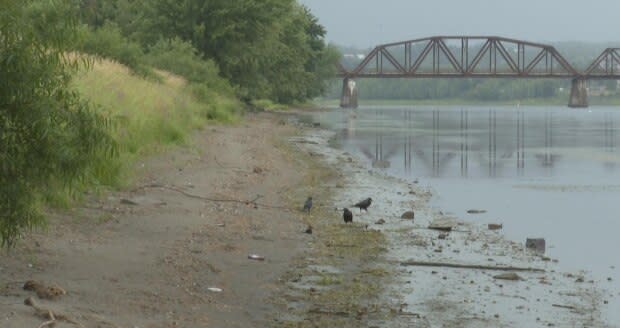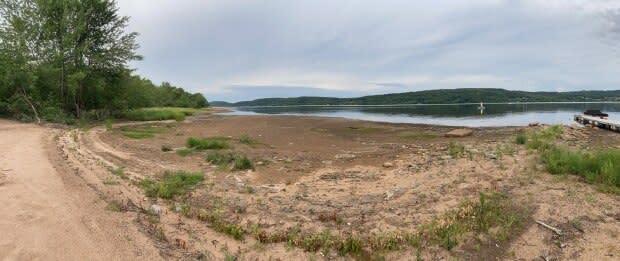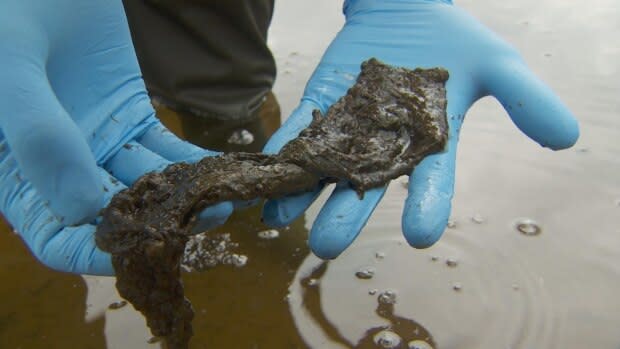St. John River bottom exposed as water levels dip well below normal

As huge sections of the St. John River bottom sit high and dry along Route 105 in Maugerville, boaters would do well to heed the channel markers to avoid the same fate.
"The river is as low as I've seen it in a long time," said Reno Fountaine of Middle Island Marina. "And I've been boating here for over 20 years."
So far, he said, the large sandbars in the middle of the river haven't created problems for boaters.
"Most boaters, if they're following where they should be, and following the channel markers, there's lots of water," said Fountaine.
But the exposed river bottom is indicative of the kind of summer it's been in New Brunswick — hot and dry.
In fact, the last six months have seen about half the precipitation as the same time last year did — and 2019 was also on the dry side.

Every month has been below the monthly average for precipitation — going all the way back to December, said Environment Canada meteorologist Jill Maepea.
June, for example, saw less than one-third the normal precipitation for the province, and several areas — Bas-Caraquet, Charlo, Sackville and Bouctouche — set all-time lows for precipitation for the month.
Add above-normal temperatures, said Maepea, and no wonder river levels are so low.
For the month of July, total precipitation and streamflow amounts were below normal for most of the province, said Anne Mooers, the director of communications for the Department of Environment and Local Government.
"This continues to result in low surface water and groundwater levels," said Mooers.
According to Agriculture Canada's drought monitor, the majority of New Brunswick is experiencing "severe" or "moderate" drought, while a small section in the south-central area is labelled as "abnormally" dry.
River navigation
The owner of a houseboat rental business on the St. John River said in some ways, the low water levels make navigation safer.
"In some of the worst places for hidden hazards, they're actually sticking out of the water now," said Larry Jewett, owner of Lakeway Houseboat Vacations of Mactaquac.
And that makes them more visible to boaters who may not be familiar with the St. John River and its tributaries and the hazards beneath.

He said he's seen water levels lower "from time to time," but it usually only lasts for a couple of days. He said it's rare to see water levels remain so low for so long.
Jewett, who also operates the Mactaquac marina, said he's had to adjust the steps for the dock, but since water levels have been consistently low, once he made the change, he hasn't had to fiddle with it.
Those who have had a tough time this summer are the cottage owners with flat waterfront, he said. Those people have had to move their docks further out as more of the river bottom sits high and dry on the shoreline.
Smaller waterways
While there's still plenty of water in most of the St. John River, some of the smaller waterways are now impassable to watercraft of any size.
The Kennebecasis River, for example, is unusually low, said Ben Whalen, the project manager for the Kennebecasis Watershed Restoration Committee.
On a recent paddle between Norton and Bloomfield, Whalen and his colleagues had to get out and drag their kayaks and canoes across several dry spots.
"There were many more areas where we would be pulling our canoes and kayaks over some gravel bars and stuff like that, whereas in past years, we probably wouldn't have had to do that," Whalen said.

He said last year also saw below-average precipitation, and that's contributing to this year's low levels.
But even one dry year can have an impact on the ecosystem by favouring certain species, to the detriment of others, he said.
Smallmouth bass, for example, are more resilient in the hot, dry conditions than some native species such as salmon and brook trout.
"So those kinds of considerations have to be looked at long term," said Whalen.
Cyanobacteria
The hot dry weather can also lead to more cyanobacteria or blue-green algae, which produce toxins that can affect the brain.
Dr. Janice Lawrence, an associate professor of biology at the University of New Brunswick, said it's been a particularly prolific year for cyanobacteria in the St. John River.
While most cyanobacteria found in ponds or lakes will cause skin irritation or gastrointestinal illness, the algae populations living at the bottom of the St. John River are producing potent neurotoxins that can cause immediate paralysis, suffocation and death in dogs and other vertebrates but also pose a risk to people.

Dr. Cristin Muecke, New Brunswick's deputy chief medical officer of health, said the risk posed by neurotoxins is theoretically possible but "very unlikely" in a practical sense. A person would have to ingest a large amount.
But health and veterinary officials are still urging people to take precautions to protect themselves and their pets along the river and other recreational waterways.
The number one protective measure is to avoid ingestion, she said.

